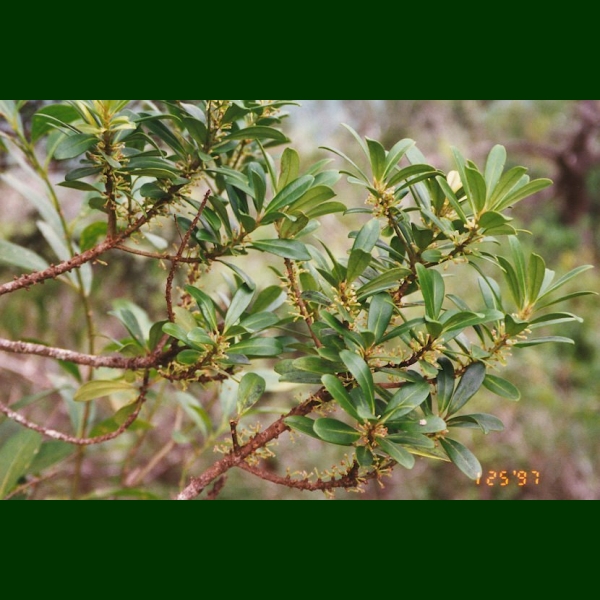 Hawaiian Name(s): kōlea, kōlea lau li‘i (M. sandwicensis)
Hawaiian Name(s): kōlea, kōlea lau li‘i (M. sandwicensis)Scientific Name: Myrsine (20 species)
Vernacular Name: none
Family: Primulaceae
Status: endemic
Authority: M. alyxifolia Hosaka, M. degeneri Hosaka, M. denticulata (Wawra) Hosaka, M. emarginata (Rock) Hosaka, M. ferneei (Mez) Hosaka, M. fosbergii Hosaka, M. helleri (O.Deg. & I.Deg.) H.St.John, M. juddii Hosaka, M. kauaiensis Hillebr., M. lanaiensis Hillebr., M. lessertiana A.DC., M. linerarifolia Hosaka, M. mezii Hosaka, M. petiolata Hosaka, M. pukooensis (H.Lev.) Hosaka, M. punctata (H.Lev.) Wilbur, M. sandwicensis A.DC., M. vaccinioides W.L.Wagner, D.R.Herbst & Sohmer
Description: Shrubs/small trees to 20 m tall.
Habitat Species vary in habitat specifics, but most favor wet forests; some also in mesic forest and near bogs. Many restricted to single islands (Wagner et al. 1990:937–947).
Medicines:
Non Medicinal Uses: Bark for dye (Hillebrand 1888:280); wood for kapa anvils (kua kuku kapa) and charcoal/ashes for dye (Malo 1951:21); trunks and branches for posts and beams in house construction (Degener 1930:249; Lamb 1981:107); canoe gunwales (Krauss 1993:50). In the Ethnology Collection at Bishop Museum there is a post-contact example of the wood made into a bowl.
Specific gravity of wood: unknown
Famous Locations:
Mele:
`Ōlelo Noeau:
Dye Color and Parts: Red (bark) and black (stem)
Kino lau:
Location on Bishop Museum Kalihi Campus:
Propagation Information: Intermediate. Sew with seed coat in tact. Slow germination and growth. Do not pull off attached seed coat. Leave in seedbed for 3–4 weeks after there are at least 3 leaves. After transplanting seedlings are very sensitive to drying out. Culliney and Koebele report no success in transferring kōlea from pots to open ground (1999:91–93).
Native Plants Hawaii.
Seed: Seed length approximately 4 mm. Photograph: H.Lennstrom. Species: M. lessertiana.

